Business Model Systems: Conceptualization, Innovation, and Change
VerifiedAdded on 2020/03/01
|11
|2373
|220
Essay
AI Summary
This essay delves into the concept of business model systems, defining them as pictorial representations of various business aspects, including activities, finances, employees, and policies, designed to enhance operational efficiency and goal achievement. The essay emphasizes the importance of a well-conceptualized business model system in creating value, managing innovation, solving problems, and distributing value effectively. It explores e-business archetypes for online transactions, the significance of aligning business models with company activities, and the role of cost and revenue architecture in identifying profitable ventures and generating revenue. The essay also addresses how business model conceptualization aids in solving static and dynamic problems, using the Coca-Cola Company as a case study to illustrate the inevitability and impact of change on business models. It concludes by highlighting key considerations for managers when designing business models, such as acknowledging change and integrating effective cost and revenue structures to ensure business effectiveness and efficiency.
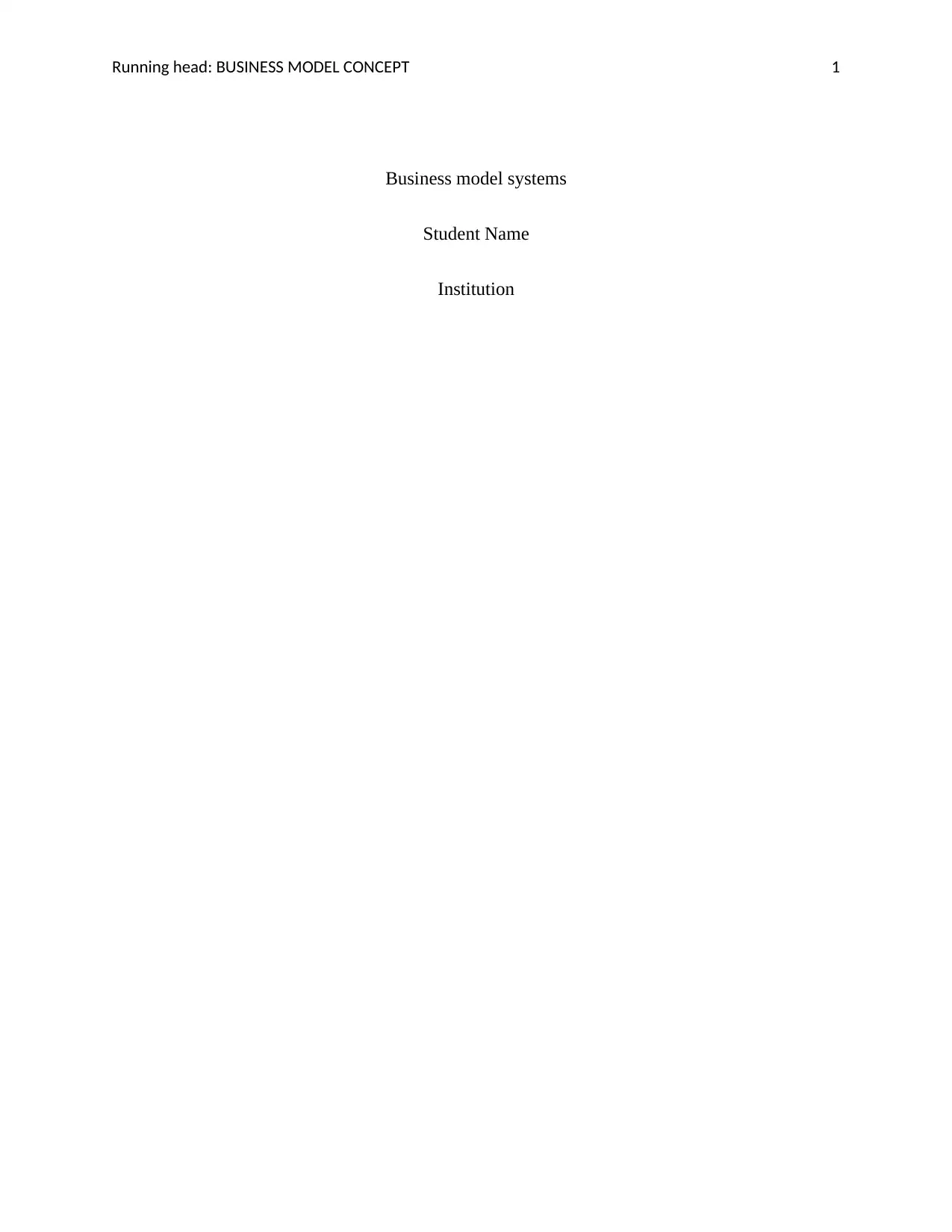
Running head: BUSINESS MODEL CONCEPT 1
Business model systems
Student Name
Institution
Business model systems
Student Name
Institution
Paraphrase This Document
Need a fresh take? Get an instant paraphrase of this document with our AI Paraphraser
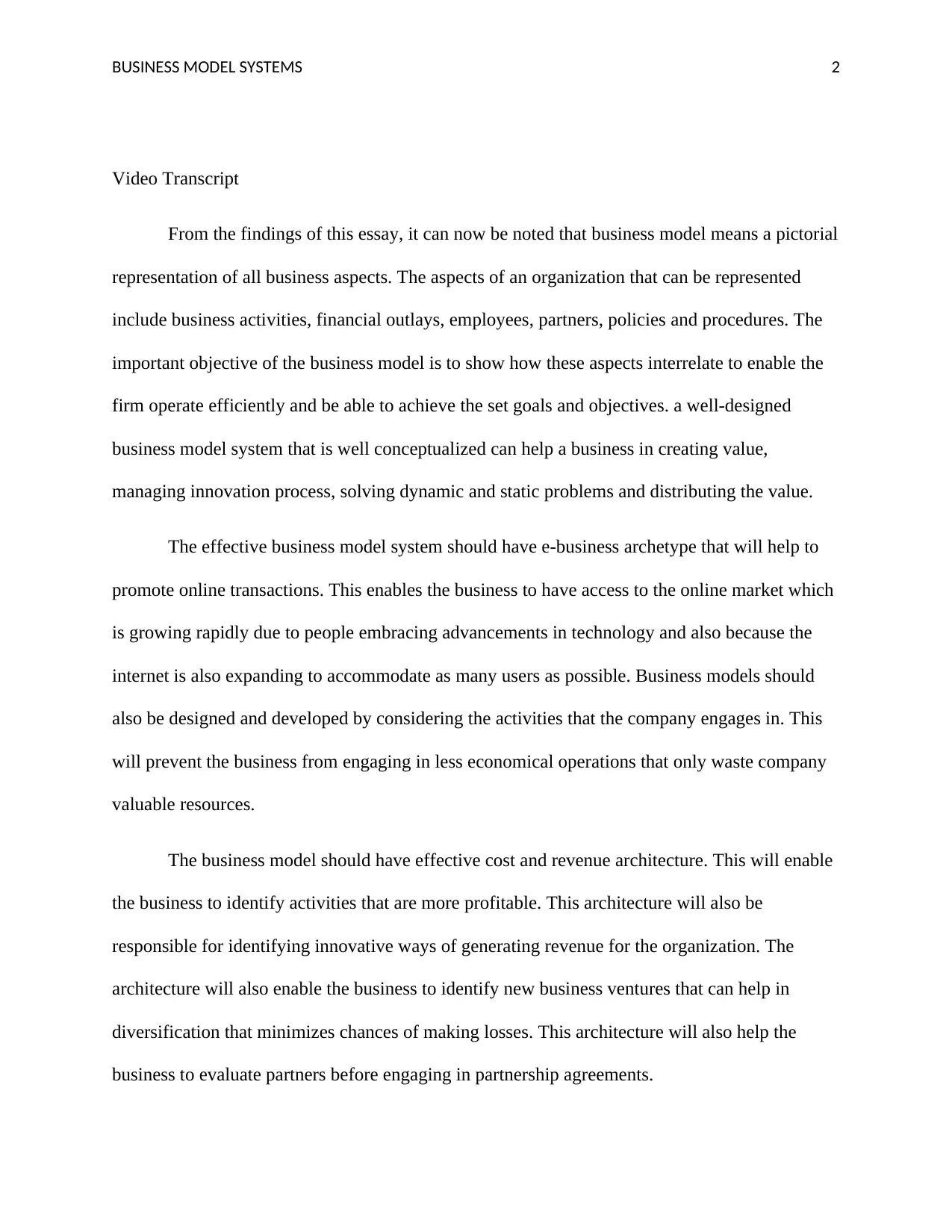
BUSINESS MODEL SYSTEMS 2
Video Transcript
From the findings of this essay, it can now be noted that business model means a pictorial
representation of all business aspects. The aspects of an organization that can be represented
include business activities, financial outlays, employees, partners, policies and procedures. The
important objective of the business model is to show how these aspects interrelate to enable the
firm operate efficiently and be able to achieve the set goals and objectives. a well-designed
business model system that is well conceptualized can help a business in creating value,
managing innovation process, solving dynamic and static problems and distributing the value.
The effective business model system should have e-business archetype that will help to
promote online transactions. This enables the business to have access to the online market which
is growing rapidly due to people embracing advancements in technology and also because the
internet is also expanding to accommodate as many users as possible. Business models should
also be designed and developed by considering the activities that the company engages in. This
will prevent the business from engaging in less economical operations that only waste company
valuable resources.
The business model should have effective cost and revenue architecture. This will enable
the business to identify activities that are more profitable. This architecture will also be
responsible for identifying innovative ways of generating revenue for the organization. The
architecture will also enable the business to identify new business ventures that can help in
diversification that minimizes chances of making losses. This architecture will also help the
business to evaluate partners before engaging in partnership agreements.
Video Transcript
From the findings of this essay, it can now be noted that business model means a pictorial
representation of all business aspects. The aspects of an organization that can be represented
include business activities, financial outlays, employees, partners, policies and procedures. The
important objective of the business model is to show how these aspects interrelate to enable the
firm operate efficiently and be able to achieve the set goals and objectives. a well-designed
business model system that is well conceptualized can help a business in creating value,
managing innovation process, solving dynamic and static problems and distributing the value.
The effective business model system should have e-business archetype that will help to
promote online transactions. This enables the business to have access to the online market which
is growing rapidly due to people embracing advancements in technology and also because the
internet is also expanding to accommodate as many users as possible. Business models should
also be designed and developed by considering the activities that the company engages in. This
will prevent the business from engaging in less economical operations that only waste company
valuable resources.
The business model should have effective cost and revenue architecture. This will enable
the business to identify activities that are more profitable. This architecture will also be
responsible for identifying innovative ways of generating revenue for the organization. The
architecture will also enable the business to identify new business ventures that can help in
diversification that minimizes chances of making losses. This architecture will also help the
business to evaluate partners before engaging in partnership agreements.
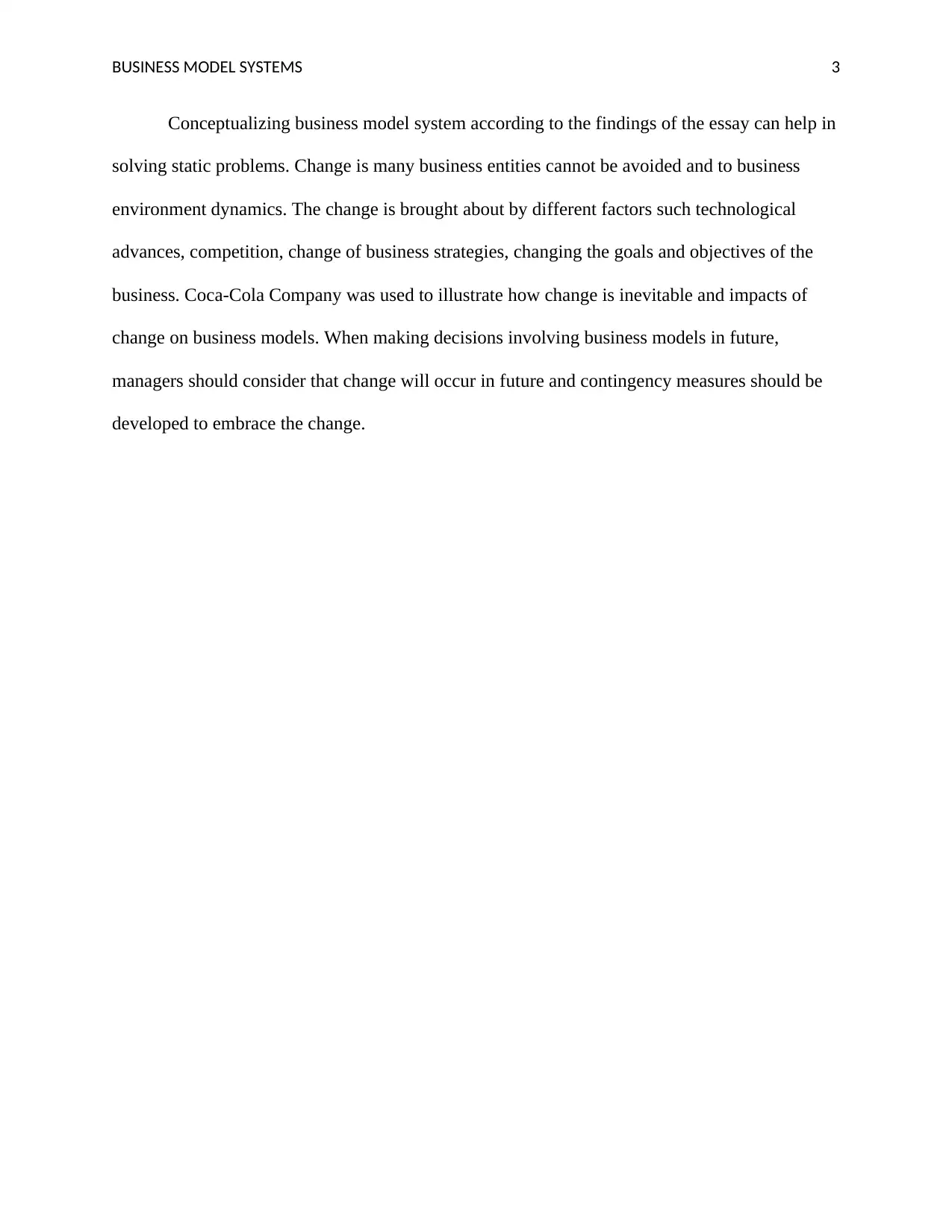
BUSINESS MODEL SYSTEMS 3
Conceptualizing business model system according to the findings of the essay can help in
solving static problems. Change is many business entities cannot be avoided and to business
environment dynamics. The change is brought about by different factors such technological
advances, competition, change of business strategies, changing the goals and objectives of the
business. Coca-Cola Company was used to illustrate how change is inevitable and impacts of
change on business models. When making decisions involving business models in future,
managers should consider that change will occur in future and contingency measures should be
developed to embrace the change.
Conceptualizing business model system according to the findings of the essay can help in
solving static problems. Change is many business entities cannot be avoided and to business
environment dynamics. The change is brought about by different factors such technological
advances, competition, change of business strategies, changing the goals and objectives of the
business. Coca-Cola Company was used to illustrate how change is inevitable and impacts of
change on business models. When making decisions involving business models in future,
managers should consider that change will occur in future and contingency measures should be
developed to embrace the change.
⊘ This is a preview!⊘
Do you want full access?
Subscribe today to unlock all pages.

Trusted by 1+ million students worldwide
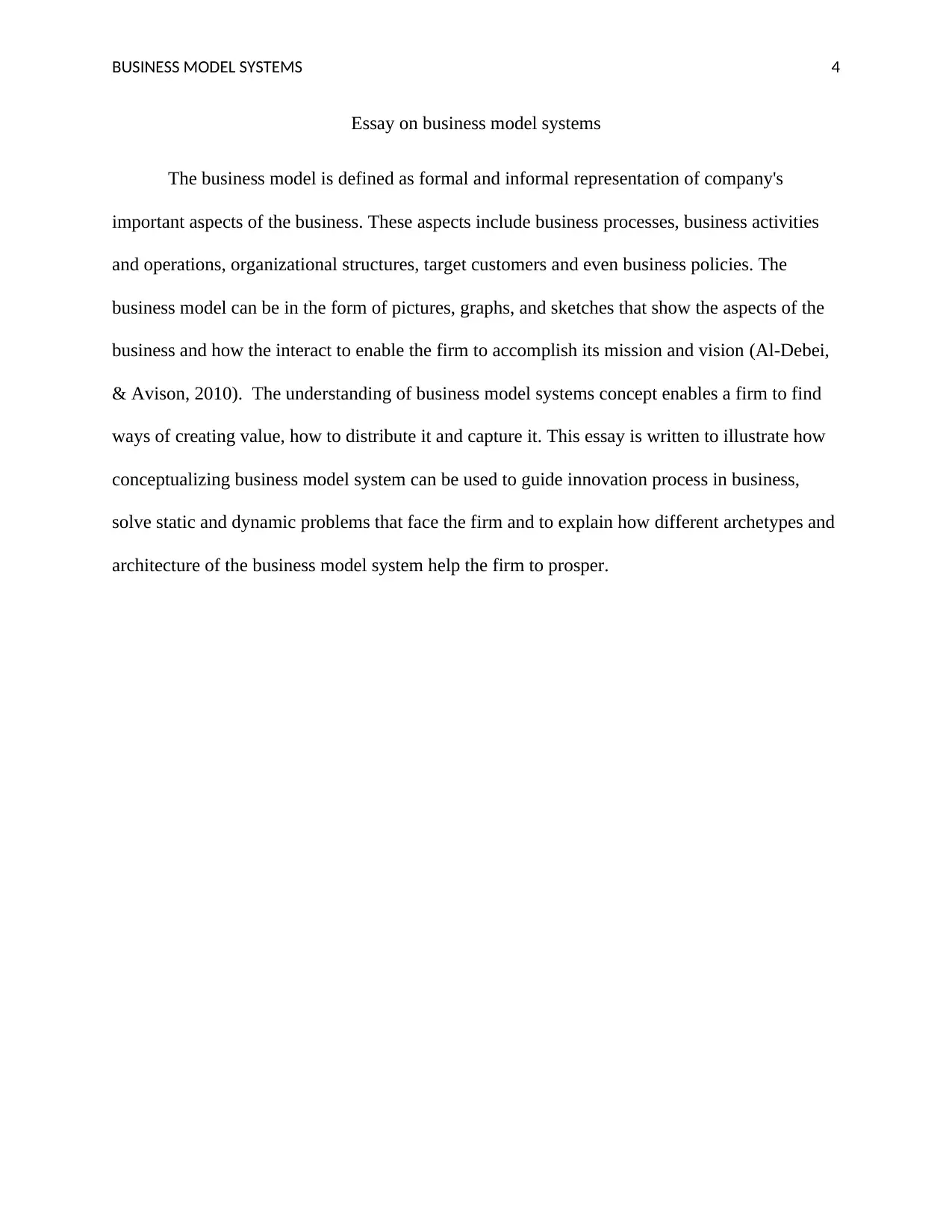
BUSINESS MODEL SYSTEMS 4
Essay on business model systems
The business model is defined as formal and informal representation of company's
important aspects of the business. These aspects include business processes, business activities
and operations, organizational structures, target customers and even business policies. The
business model can be in the form of pictures, graphs, and sketches that show the aspects of the
business and how the interact to enable the firm to accomplish its mission and vision (Al-Debei,
& Avison, 2010). The understanding of business model systems concept enables a firm to find
ways of creating value, how to distribute it and capture it. This essay is written to illustrate how
conceptualizing business model system can be used to guide innovation process in business,
solve static and dynamic problems that face the firm and to explain how different archetypes and
architecture of the business model system help the firm to prosper.
Essay on business model systems
The business model is defined as formal and informal representation of company's
important aspects of the business. These aspects include business processes, business activities
and operations, organizational structures, target customers and even business policies. The
business model can be in the form of pictures, graphs, and sketches that show the aspects of the
business and how the interact to enable the firm to accomplish its mission and vision (Al-Debei,
& Avison, 2010). The understanding of business model systems concept enables a firm to find
ways of creating value, how to distribute it and capture it. This essay is written to illustrate how
conceptualizing business model system can be used to guide innovation process in business,
solve static and dynamic problems that face the firm and to explain how different archetypes and
architecture of the business model system help the firm to prosper.
Paraphrase This Document
Need a fresh take? Get an instant paraphrase of this document with our AI Paraphraser
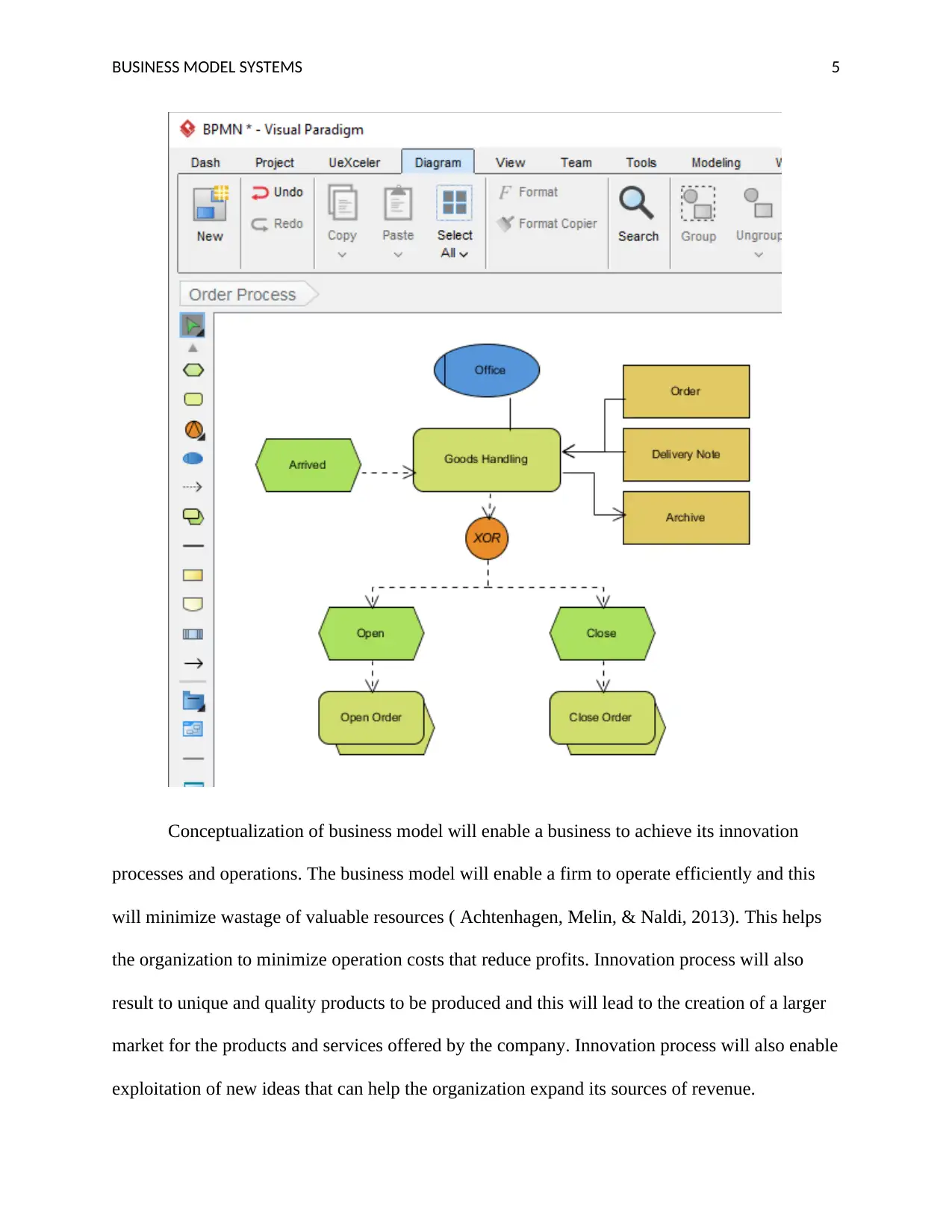
BUSINESS MODEL SYSTEMS 5
Conceptualization of business model will enable a business to achieve its innovation
processes and operations. The business model will enable a firm to operate efficiently and this
will minimize wastage of valuable resources ( Achtenhagen, Melin, & Naldi, 2013). This helps
the organization to minimize operation costs that reduce profits. Innovation process will also
result to unique and quality products to be produced and this will lead to the creation of a larger
market for the products and services offered by the company. Innovation process will also enable
exploitation of new ideas that can help the organization expand its sources of revenue.
Conceptualization of business model will enable a business to achieve its innovation
processes and operations. The business model will enable a firm to operate efficiently and this
will minimize wastage of valuable resources ( Achtenhagen, Melin, & Naldi, 2013). This helps
the organization to minimize operation costs that reduce profits. Innovation process will also
result to unique and quality products to be produced and this will lead to the creation of a larger
market for the products and services offered by the company. Innovation process will also enable
exploitation of new ideas that can help the organization expand its sources of revenue.
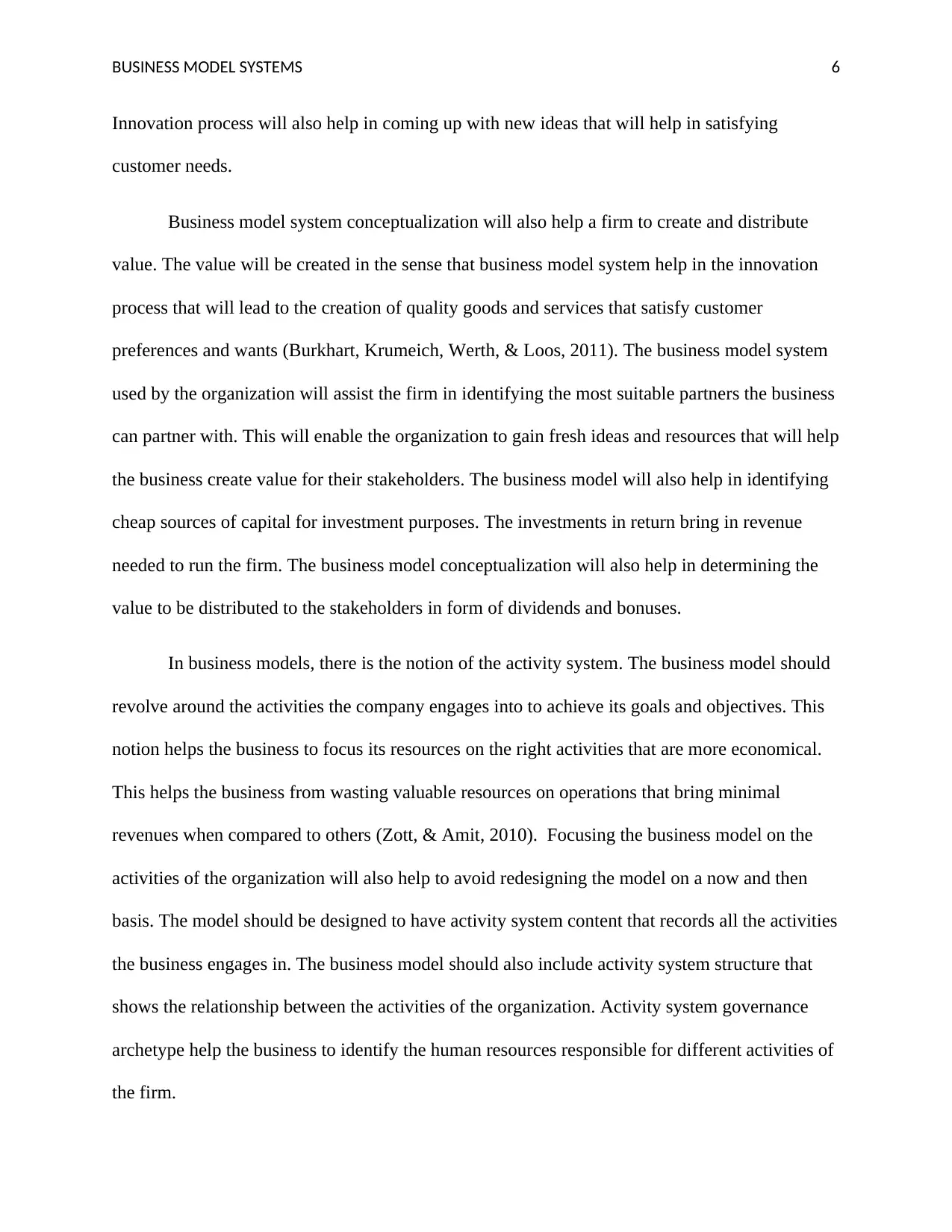
BUSINESS MODEL SYSTEMS 6
Innovation process will also help in coming up with new ideas that will help in satisfying
customer needs.
Business model system conceptualization will also help a firm to create and distribute
value. The value will be created in the sense that business model system help in the innovation
process that will lead to the creation of quality goods and services that satisfy customer
preferences and wants (Burkhart, Krumeich, Werth, & Loos, 2011). The business model system
used by the organization will assist the firm in identifying the most suitable partners the business
can partner with. This will enable the organization to gain fresh ideas and resources that will help
the business create value for their stakeholders. The business model will also help in identifying
cheap sources of capital for investment purposes. The investments in return bring in revenue
needed to run the firm. The business model conceptualization will also help in determining the
value to be distributed to the stakeholders in form of dividends and bonuses.
In business models, there is the notion of the activity system. The business model should
revolve around the activities the company engages into to achieve its goals and objectives. This
notion helps the business to focus its resources on the right activities that are more economical.
This helps the business from wasting valuable resources on operations that bring minimal
revenues when compared to others (Zott, & Amit, 2010). Focusing the business model on the
activities of the organization will also help to avoid redesigning the model on a now and then
basis. The model should be designed to have activity system content that records all the activities
the business engages in. The business model should also include activity system structure that
shows the relationship between the activities of the organization. Activity system governance
archetype help the business to identify the human resources responsible for different activities of
the firm.
Innovation process will also help in coming up with new ideas that will help in satisfying
customer needs.
Business model system conceptualization will also help a firm to create and distribute
value. The value will be created in the sense that business model system help in the innovation
process that will lead to the creation of quality goods and services that satisfy customer
preferences and wants (Burkhart, Krumeich, Werth, & Loos, 2011). The business model system
used by the organization will assist the firm in identifying the most suitable partners the business
can partner with. This will enable the organization to gain fresh ideas and resources that will help
the business create value for their stakeholders. The business model will also help in identifying
cheap sources of capital for investment purposes. The investments in return bring in revenue
needed to run the firm. The business model conceptualization will also help in determining the
value to be distributed to the stakeholders in form of dividends and bonuses.
In business models, there is the notion of the activity system. The business model should
revolve around the activities the company engages into to achieve its goals and objectives. This
notion helps the business to focus its resources on the right activities that are more economical.
This helps the business from wasting valuable resources on operations that bring minimal
revenues when compared to others (Zott, & Amit, 2010). Focusing the business model on the
activities of the organization will also help to avoid redesigning the model on a now and then
basis. The model should be designed to have activity system content that records all the activities
the business engages in. The business model should also include activity system structure that
shows the relationship between the activities of the organization. Activity system governance
archetype help the business to identify the human resources responsible for different activities of
the firm.
⊘ This is a preview!⊘
Do you want full access?
Subscribe today to unlock all pages.

Trusted by 1+ million students worldwide
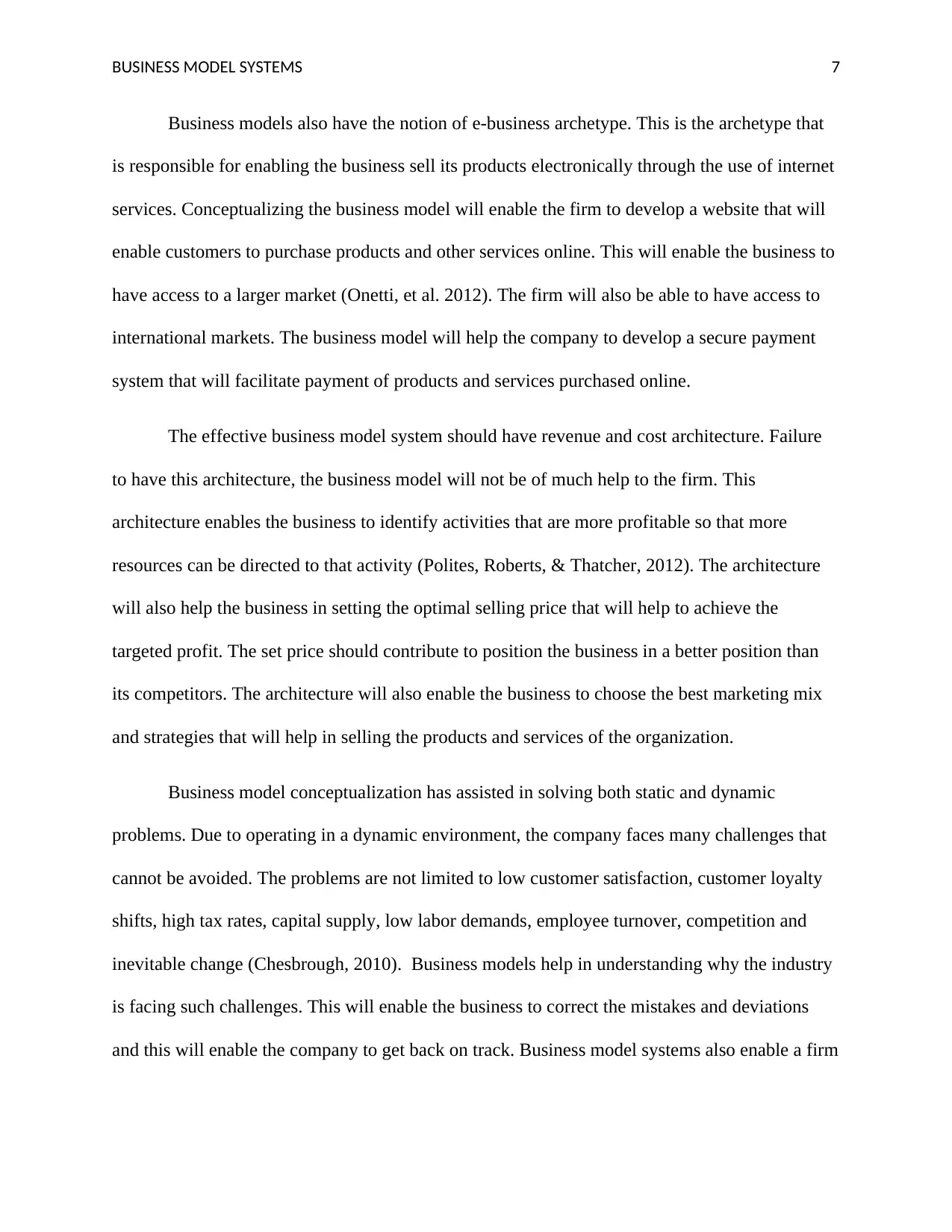
BUSINESS MODEL SYSTEMS 7
Business models also have the notion of e-business archetype. This is the archetype that
is responsible for enabling the business sell its products electronically through the use of internet
services. Conceptualizing the business model will enable the firm to develop a website that will
enable customers to purchase products and other services online. This will enable the business to
have access to a larger market (Onetti, et al. 2012). The firm will also be able to have access to
international markets. The business model will help the company to develop a secure payment
system that will facilitate payment of products and services purchased online.
The effective business model system should have revenue and cost architecture. Failure
to have this architecture, the business model will not be of much help to the firm. This
architecture enables the business to identify activities that are more profitable so that more
resources can be directed to that activity (Polites, Roberts, & Thatcher, 2012). The architecture
will also help the business in setting the optimal selling price that will help to achieve the
targeted profit. The set price should contribute to position the business in a better position than
its competitors. The architecture will also enable the business to choose the best marketing mix
and strategies that will help in selling the products and services of the organization.
Business model conceptualization has assisted in solving both static and dynamic
problems. Due to operating in a dynamic environment, the company faces many challenges that
cannot be avoided. The problems are not limited to low customer satisfaction, customer loyalty
shifts, high tax rates, capital supply, low labor demands, employee turnover, competition and
inevitable change (Chesbrough, 2010). Business models help in understanding why the industry
is facing such challenges. This will enable the business to correct the mistakes and deviations
and this will enable the company to get back on track. Business model systems also enable a firm
Business models also have the notion of e-business archetype. This is the archetype that
is responsible for enabling the business sell its products electronically through the use of internet
services. Conceptualizing the business model will enable the firm to develop a website that will
enable customers to purchase products and other services online. This will enable the business to
have access to a larger market (Onetti, et al. 2012). The firm will also be able to have access to
international markets. The business model will help the company to develop a secure payment
system that will facilitate payment of products and services purchased online.
The effective business model system should have revenue and cost architecture. Failure
to have this architecture, the business model will not be of much help to the firm. This
architecture enables the business to identify activities that are more profitable so that more
resources can be directed to that activity (Polites, Roberts, & Thatcher, 2012). The architecture
will also help the business in setting the optimal selling price that will help to achieve the
targeted profit. The set price should contribute to position the business in a better position than
its competitors. The architecture will also enable the business to choose the best marketing mix
and strategies that will help in selling the products and services of the organization.
Business model conceptualization has assisted in solving both static and dynamic
problems. Due to operating in a dynamic environment, the company faces many challenges that
cannot be avoided. The problems are not limited to low customer satisfaction, customer loyalty
shifts, high tax rates, capital supply, low labor demands, employee turnover, competition and
inevitable change (Chesbrough, 2010). Business models help in understanding why the industry
is facing such challenges. This will enable the business to correct the mistakes and deviations
and this will enable the company to get back on track. Business model systems also enable a firm
Paraphrase This Document
Need a fresh take? Get an instant paraphrase of this document with our AI Paraphraser
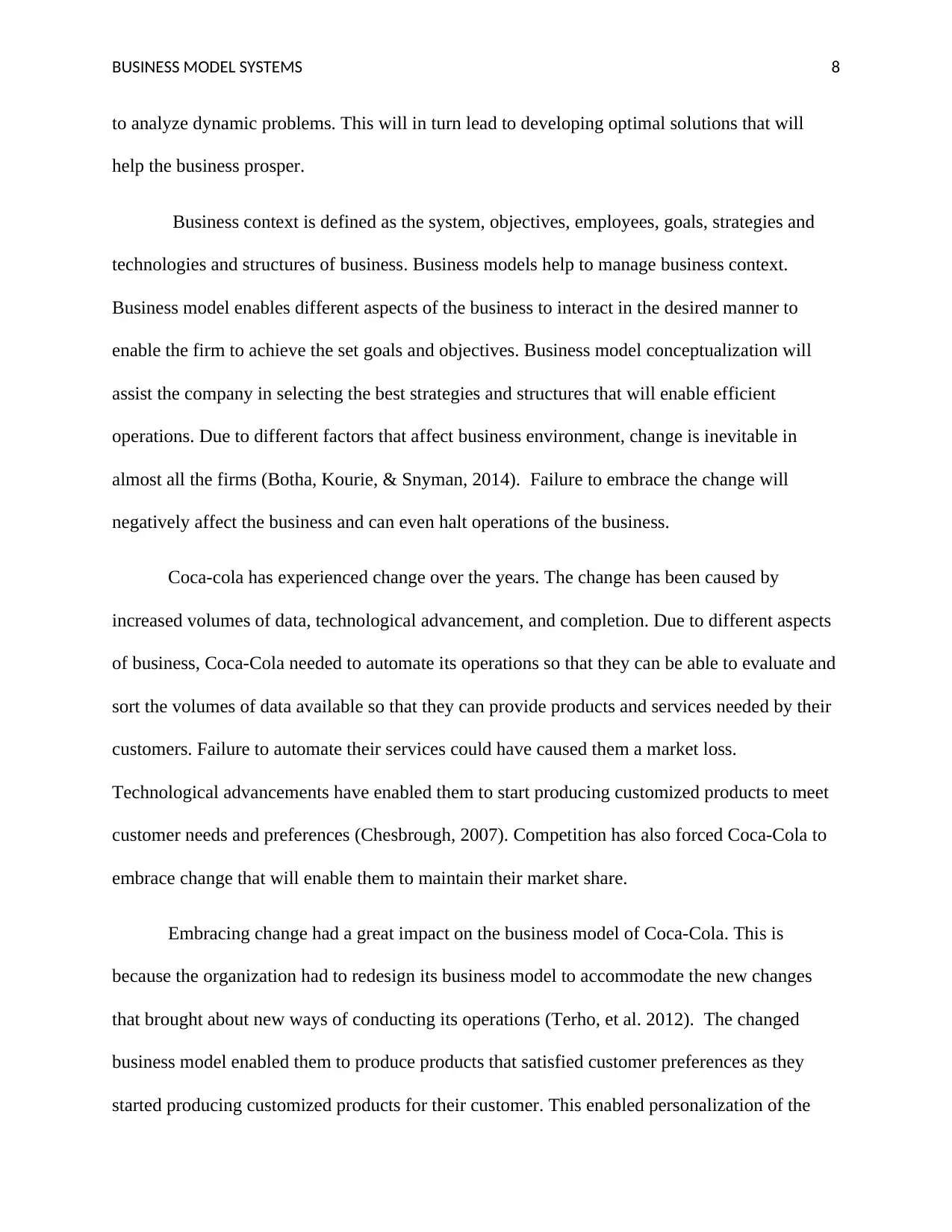
BUSINESS MODEL SYSTEMS 8
to analyze dynamic problems. This will in turn lead to developing optimal solutions that will
help the business prosper.
Business context is defined as the system, objectives, employees, goals, strategies and
technologies and structures of business. Business models help to manage business context.
Business model enables different aspects of the business to interact in the desired manner to
enable the firm to achieve the set goals and objectives. Business model conceptualization will
assist the company in selecting the best strategies and structures that will enable efficient
operations. Due to different factors that affect business environment, change is inevitable in
almost all the firms (Botha, Kourie, & Snyman, 2014). Failure to embrace the change will
negatively affect the business and can even halt operations of the business.
Coca-cola has experienced change over the years. The change has been caused by
increased volumes of data, technological advancement, and completion. Due to different aspects
of business, Coca-Cola needed to automate its operations so that they can be able to evaluate and
sort the volumes of data available so that they can provide products and services needed by their
customers. Failure to automate their services could have caused them a market loss.
Technological advancements have enabled them to start producing customized products to meet
customer needs and preferences (Chesbrough, 2007). Competition has also forced Coca-Cola to
embrace change that will enable them to maintain their market share.
Embracing change had a great impact on the business model of Coca-Cola. This is
because the organization had to redesign its business model to accommodate the new changes
that brought about new ways of conducting its operations (Terho, et al. 2012). The changed
business model enabled them to produce products that satisfied customer preferences as they
started producing customized products for their customer. This enabled personalization of the
to analyze dynamic problems. This will in turn lead to developing optimal solutions that will
help the business prosper.
Business context is defined as the system, objectives, employees, goals, strategies and
technologies and structures of business. Business models help to manage business context.
Business model enables different aspects of the business to interact in the desired manner to
enable the firm to achieve the set goals and objectives. Business model conceptualization will
assist the company in selecting the best strategies and structures that will enable efficient
operations. Due to different factors that affect business environment, change is inevitable in
almost all the firms (Botha, Kourie, & Snyman, 2014). Failure to embrace the change will
negatively affect the business and can even halt operations of the business.
Coca-cola has experienced change over the years. The change has been caused by
increased volumes of data, technological advancement, and completion. Due to different aspects
of business, Coca-Cola needed to automate its operations so that they can be able to evaluate and
sort the volumes of data available so that they can provide products and services needed by their
customers. Failure to automate their services could have caused them a market loss.
Technological advancements have enabled them to start producing customized products to meet
customer needs and preferences (Chesbrough, 2007). Competition has also forced Coca-Cola to
embrace change that will enable them to maintain their market share.
Embracing change had a great impact on the business model of Coca-Cola. This is
because the organization had to redesign its business model to accommodate the new changes
that brought about new ways of conducting its operations (Terho, et al. 2012). The changed
business model enabled them to produce products that satisfied customer preferences as they
started producing customized products for their customer. This enabled personalization of the
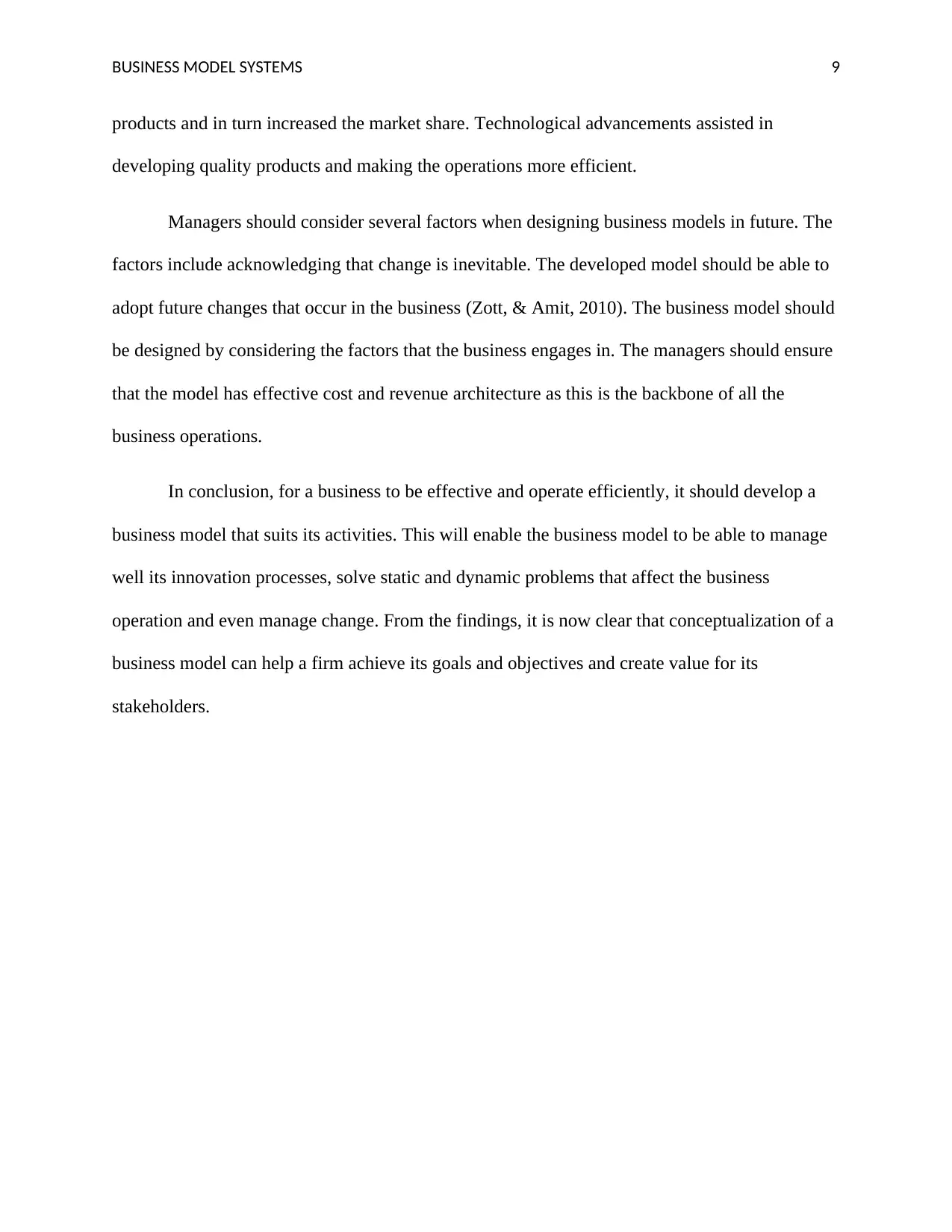
BUSINESS MODEL SYSTEMS 9
products and in turn increased the market share. Technological advancements assisted in
developing quality products and making the operations more efficient.
Managers should consider several factors when designing business models in future. The
factors include acknowledging that change is inevitable. The developed model should be able to
adopt future changes that occur in the business (Zott, & Amit, 2010). The business model should
be designed by considering the factors that the business engages in. The managers should ensure
that the model has effective cost and revenue architecture as this is the backbone of all the
business operations.
In conclusion, for a business to be effective and operate efficiently, it should develop a
business model that suits its activities. This will enable the business model to be able to manage
well its innovation processes, solve static and dynamic problems that affect the business
operation and even manage change. From the findings, it is now clear that conceptualization of a
business model can help a firm achieve its goals and objectives and create value for its
stakeholders.
products and in turn increased the market share. Technological advancements assisted in
developing quality products and making the operations more efficient.
Managers should consider several factors when designing business models in future. The
factors include acknowledging that change is inevitable. The developed model should be able to
adopt future changes that occur in the business (Zott, & Amit, 2010). The business model should
be designed by considering the factors that the business engages in. The managers should ensure
that the model has effective cost and revenue architecture as this is the backbone of all the
business operations.
In conclusion, for a business to be effective and operate efficiently, it should develop a
business model that suits its activities. This will enable the business model to be able to manage
well its innovation processes, solve static and dynamic problems that affect the business
operation and even manage change. From the findings, it is now clear that conceptualization of a
business model can help a firm achieve its goals and objectives and create value for its
stakeholders.
⊘ This is a preview!⊘
Do you want full access?
Subscribe today to unlock all pages.

Trusted by 1+ million students worldwide
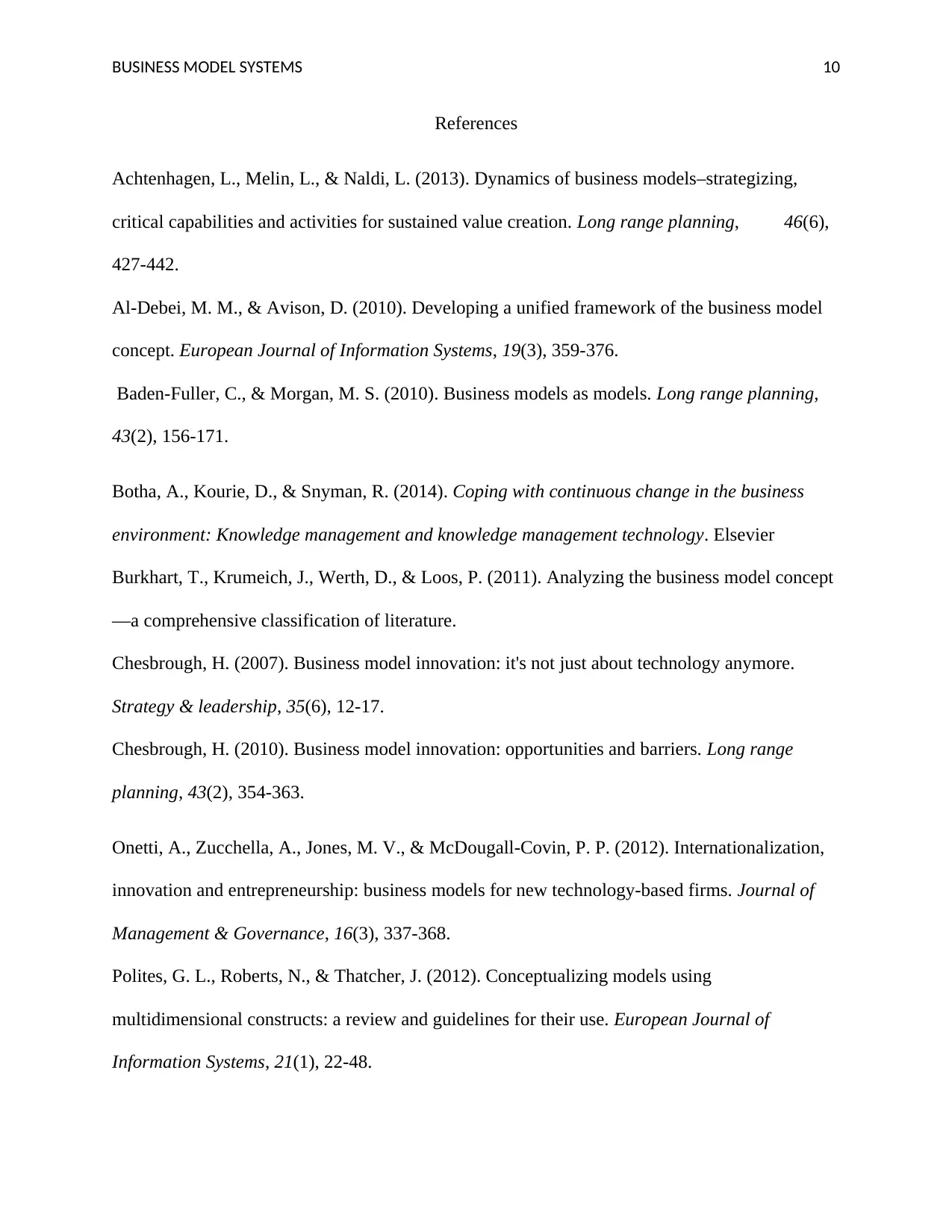
BUSINESS MODEL SYSTEMS 10
References
Achtenhagen, L., Melin, L., & Naldi, L. (2013). Dynamics of business models–strategizing,
critical capabilities and activities for sustained value creation. Long range planning, 46(6),
427-442.
Al-Debei, M. M., & Avison, D. (2010). Developing a unified framework of the business model
concept. European Journal of Information Systems, 19(3), 359-376.
Baden-Fuller, C., & Morgan, M. S. (2010). Business models as models. Long range planning,
43(2), 156-171.
Botha, A., Kourie, D., & Snyman, R. (2014). Coping with continuous change in the business
environment: Knowledge management and knowledge management technology. Elsevier
Burkhart, T., Krumeich, J., Werth, D., & Loos, P. (2011). Analyzing the business model concept
—a comprehensive classification of literature.
Chesbrough, H. (2007). Business model innovation: it's not just about technology anymore.
Strategy & leadership, 35(6), 12-17.
Chesbrough, H. (2010). Business model innovation: opportunities and barriers. Long range
planning, 43(2), 354-363.
Onetti, A., Zucchella, A., Jones, M. V., & McDougall-Covin, P. P. (2012). Internationalization,
innovation and entrepreneurship: business models for new technology-based firms. Journal of
Management & Governance, 16(3), 337-368.
Polites, G. L., Roberts, N., & Thatcher, J. (2012). Conceptualizing models using
multidimensional constructs: a review and guidelines for their use. European Journal of
Information Systems, 21(1), 22-48.
References
Achtenhagen, L., Melin, L., & Naldi, L. (2013). Dynamics of business models–strategizing,
critical capabilities and activities for sustained value creation. Long range planning, 46(6),
427-442.
Al-Debei, M. M., & Avison, D. (2010). Developing a unified framework of the business model
concept. European Journal of Information Systems, 19(3), 359-376.
Baden-Fuller, C., & Morgan, M. S. (2010). Business models as models. Long range planning,
43(2), 156-171.
Botha, A., Kourie, D., & Snyman, R. (2014). Coping with continuous change in the business
environment: Knowledge management and knowledge management technology. Elsevier
Burkhart, T., Krumeich, J., Werth, D., & Loos, P. (2011). Analyzing the business model concept
—a comprehensive classification of literature.
Chesbrough, H. (2007). Business model innovation: it's not just about technology anymore.
Strategy & leadership, 35(6), 12-17.
Chesbrough, H. (2010). Business model innovation: opportunities and barriers. Long range
planning, 43(2), 354-363.
Onetti, A., Zucchella, A., Jones, M. V., & McDougall-Covin, P. P. (2012). Internationalization,
innovation and entrepreneurship: business models for new technology-based firms. Journal of
Management & Governance, 16(3), 337-368.
Polites, G. L., Roberts, N., & Thatcher, J. (2012). Conceptualizing models using
multidimensional constructs: a review and guidelines for their use. European Journal of
Information Systems, 21(1), 22-48.
Paraphrase This Document
Need a fresh take? Get an instant paraphrase of this document with our AI Paraphraser
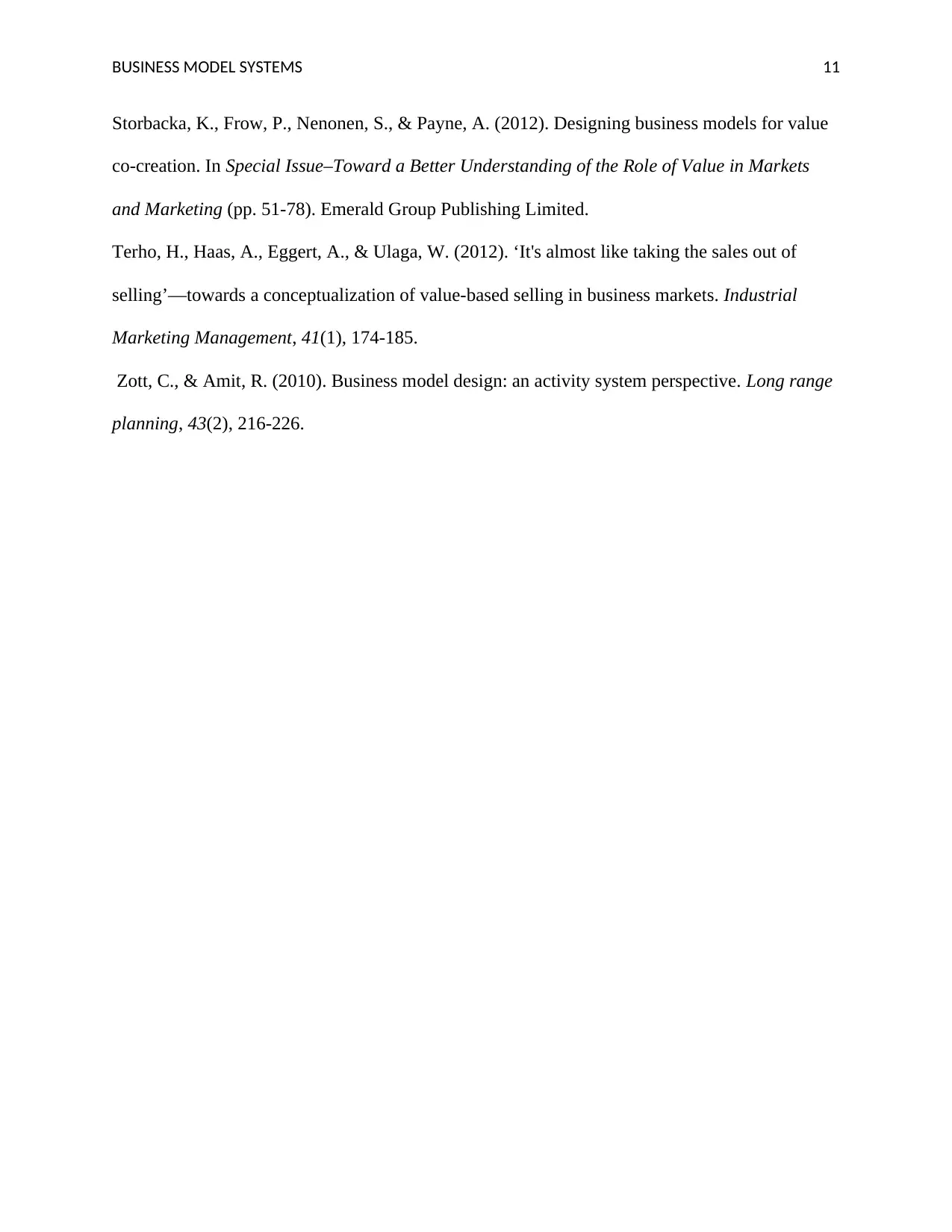
BUSINESS MODEL SYSTEMS 11
Storbacka, K., Frow, P., Nenonen, S., & Payne, A. (2012). Designing business models for value
co-creation. In Special Issue–Toward a Better Understanding of the Role of Value in Markets
and Marketing (pp. 51-78). Emerald Group Publishing Limited.
Terho, H., Haas, A., Eggert, A., & Ulaga, W. (2012). ‘It's almost like taking the sales out of
selling’—towards a conceptualization of value-based selling in business markets. Industrial
Marketing Management, 41(1), 174-185.
Zott, C., & Amit, R. (2010). Business model design: an activity system perspective. Long range
planning, 43(2), 216-226.
Storbacka, K., Frow, P., Nenonen, S., & Payne, A. (2012). Designing business models for value
co-creation. In Special Issue–Toward a Better Understanding of the Role of Value in Markets
and Marketing (pp. 51-78). Emerald Group Publishing Limited.
Terho, H., Haas, A., Eggert, A., & Ulaga, W. (2012). ‘It's almost like taking the sales out of
selling’—towards a conceptualization of value-based selling in business markets. Industrial
Marketing Management, 41(1), 174-185.
Zott, C., & Amit, R. (2010). Business model design: an activity system perspective. Long range
planning, 43(2), 216-226.
1 out of 11
Related Documents
Your All-in-One AI-Powered Toolkit for Academic Success.
+13062052269
info@desklib.com
Available 24*7 on WhatsApp / Email
![[object Object]](/_next/static/media/star-bottom.7253800d.svg)
Unlock your academic potential
Copyright © 2020–2025 A2Z Services. All Rights Reserved. Developed and managed by ZUCOL.





